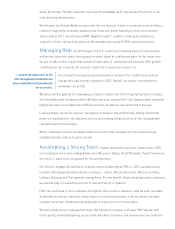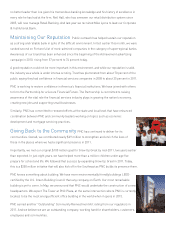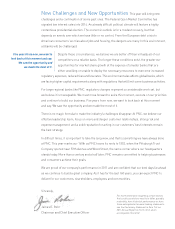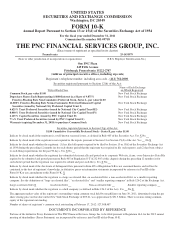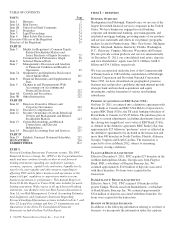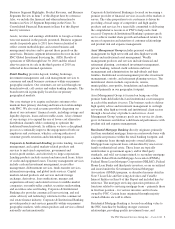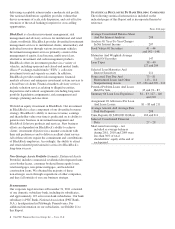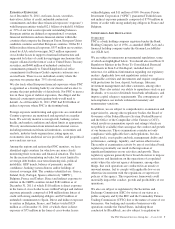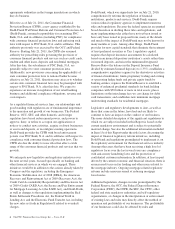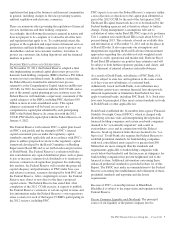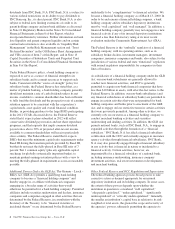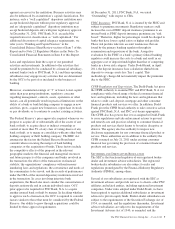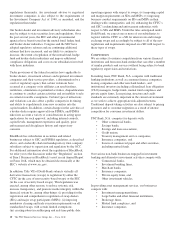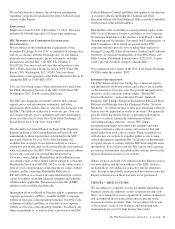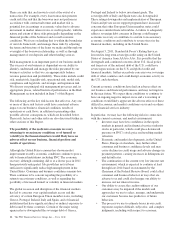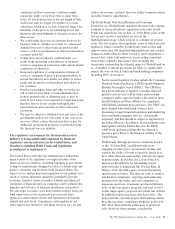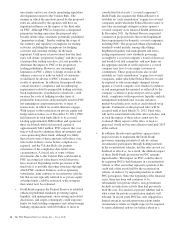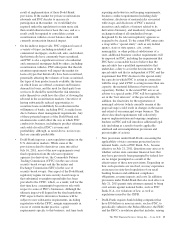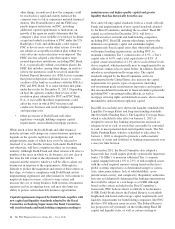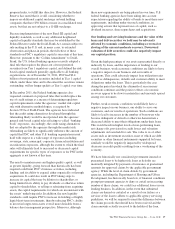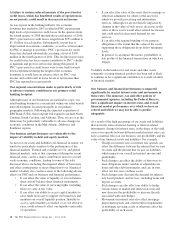PNC Bank 2011 Annual Report Download - page 17
Download and view the complete annual report
Please find page 17 of the 2011 PNC Bank annual report below. You can navigate through the pages in the report by either clicking on the pages listed below, or by using the keyword search tool below to find specific information within the annual report.
dividends from PNC Bank, N.A. PNC Bank, N.A. is subject to
various federal restrictions on its ability to pay dividends to
PNC Bancorp, Inc., its direct parent. PNC Bank, N.A. is also
subject to federal laws limiting extensions of credit to its
parent holding company and non-bank affiliates as discussed
in Note 21 Regulatory Matters in the Notes To Consolidated
Financial Statements in Item 8 of this Report, which is
incorporated herein by reference. Further information on bank
level liquidity and parent company liquidity and on certain
contractual restrictions is also available in “Liquidity Risk
Management” in the Risk Management section and “Trust
Preferred Securities” in the Off-Balance Sheet Arrangements
and VIEs section of Item 7 of this Report, and in Note 13
Capital Securities of Subsidiary Trusts and Perpetual Trust
Securities in the Notes To Consolidated Financial Statements
in Item 8 of this Report.
Under Federal Reserve policy, a bank holding company is
expected to serve as a source of financial strength to its
subsidiary banks and to commit resources to support such
banks. Consistent with the “source of strength” policy for
subsidiary banks, the Federal Reserve has stated that, as a
matter of prudent banking, a bank holding company generally
should not maintain a rate of cash dividends unless its net
income available to common shareholders has been sufficient
to fully fund the dividends and the prospective rate of earnings
retention appears to be consistent with the corporation’s
capital needs, asset quality and overall financial condition.
Further, in providing guidance to the large BHCs participating
in the 2012 CCAR, discussed above, the Federal Reserve
stated that it expects plans submitted in 2012 will reflect
conservative dividend payout ratios and net share repurchase
programs, and that requests that imply common dividend
payout ratios above 30% of projected after-tax net income
available to common shareholders will receive particularly
close scrutiny. The Federal Reserve stated that it expects
BHCs that meet the minimum capital ratio requirements under
Basel III during the transition periods provided by Basel III,
but that do not meet the fully-phased in Basel III ratio of 7
percent Tier 1 common equity (plus any applicable capital
surcharge for globally systemically important banks), to
maintain prudent earnings retention policies with a view to
meeting the fully-phased in requirement as soon as reasonably
possible.
Additional Powers Under the GLB Act. The Gramm – Leach –
Bliley Act (GLB Act) permits a qualifying bank holding
company to become a “financial holding company” and
thereby engage in, or affiliate with financial companies
engaging in, a broader range of activities than would
otherwise be permitted for a bank holding company. Permitted
affiliates include securities underwriters and dealers, insurance
companies and companies engaged in other activities that are
determined by the Federal Reserve, in consultation with the
Secretary of the Treasury, to be “financial in nature or
incidental thereto” or are determined by the Federal Reserve
unilaterally to be “complementary” to financial activities. We
became a financial holding company as of March 13, 2000. In
order to be and remain a financial holding company, a bank
holding company and its subsidiary depository institutions
must be “well capitalized” and “well managed.” In addition, a
financial holding company generally may not engage in a new
financial activity if any of its insured depository institutions
received a less than Satisfactory rating at its most recent
evaluation under the Community Reinvestment Act (CRA).
The Federal Reserve is the “umbrella” regulator of a financial
holding company, with its operating entities, such as its
subsidiary broker-dealers, investment managers, investment
companies, insurance companies and banks, also subject to the
jurisdiction of various federal and state “functional” regulators
with normal regulatory responsibility for companies in their
lines of business.
As subsidiaries of a financial holding company under the GLB
Act, our non-bank subsidiaries are generally allowed to
conduct new financial activities, and PNC is generally
permitted to acquire non-bank financial companies that have
less than $10 billion in assets, with after-the-fact notice to the
Federal Reserve. In addition, our non-bank subsidiaries (and
any financial subsidiaries of subsidiary banks) are permitted to
engage in certain activities that were not permitted for bank
holding companies and banks prior to enactment of the GLB
Act, and to engage on less restrictive terms in certain activities
that were previously permitted. Among other activities, we
currently rely on our status as a financial holding company to
conduct merchant banking activities and securities
underwriting and dealing activities. In addition, the GLB Act
permits national banks, such as PNC Bank, N.A., to engage in
expanded activities through the formation of a “financial
subsidiary.” PNC Bank, N.A. has filed a financial subsidiary
certification with the OCC and currently engages in insurance
agency activities through financial subsidiaries. PNC Bank,
N.A. may also generally engage through a financial subsidiary
in any activity that is financial in nature or incidental to a
financial activity. Certain activities, however, are
impermissible for a financial subsidiary of a national bank,
including insurance underwriting, insurance company
investment activities, real estate investment or development,
and merchant banking.
Other Federal Reserve and OCC Regulation and Supervision.
The federal banking agencies possess broad powers to take
corrective action as deemed appropriate for an insured
depository institution and its holding company. In some cases,
the extent of these powers depends upon whether the
institution in question is considered “well capitalized,”
“adequately capitalized,” “undercapitalized,” “significantly
undercapitalized” or “critically undercapitalized.” Generally,
the smaller an institution’s capital base in relation to its risk-
weighted or total assets, the greater the scope and severity of
the agencies’ powers, ultimately permitting the agencies to
8The PNC Financial Services Group, Inc. – Form 10-K


